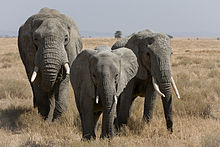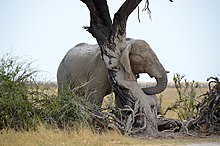Distribution and Habitat
African elephants are found widely in Sub-Saharan Africa, in dense forests, mopane and miombo woodlands, Sahelian scrub, or deserts.
Classification
In 1825, Georges Cuvier named the genus "Loxodonte". An anonymous author romanized the spelling to "Loxodonta", and the International Code of Zoological Nomenclature recognizes this as the proper authority.
- African bush elephant, Loxodonta africana
- North African elephant, Loxodonta africana pharaoensis (extinct subspecies presumed to have existed north of the Sahara from the Atlas Mountains to Ethiopia)
- African forest elephant, Loxodonta cyclotis
- Loxodonta atlantica (fossil), presumed ancestor of the modern African elephants
- Loxodonta exoptata (fossil), presumed ancestor of L. atlantica
- Loxodonta adaurora (fossil), may belong in Mammuthus
Bush and forest elephants were formerly considered subspecies of Loxodonta africana. As described in the entry for the forest elephant in the third edition of Mammal Species of the World (MSW3), there is morphological and genetic evidence that they should be considered as separate species.
Much of the evidence cited in MSW3 is morphological. The African forest elephant has a longer and narrower mandible, rounder ears, a different number of toenails, straighter and downward tusks, and considerably smaller size. With regard to the number of toenails: the African bush elephant normally has four toenails on the front foot and three on the hind feet, the African forest elephant normally has five toenails on the front foot and four on the hind foot (like the Asian elephant), but hybrids between the two species commonly occur.
MSW3 lists the two forms as full species and does not list any subspecies in its entry for Loxodonta africana. However, this approach is not taken by the United Nations Environment Programme's World Conservation Monitoring Centre nor by the International Union for Conservation of Nature (IUCN), both of which list L. cyclotis as a synonym (not even a subspecies) of L. africana. A consequence of the IUCN taking this view is that the IUCN Red List makes no independent assessment of the conservation status of the two forms of African elephant. It merely assesses the two forms taken together, as vulnerable.
A study of nuclear DNA sequences, published in 2010, indicated that the divergence date between forest and savanna elephants was 2.6 – 5.6 million years ago, similar to the divergence date estimated for the Asian elephant and the woolly mammoths (2.5 – 5.4 million years ago), which strongly supports their status as separate species. Forest elephants were found to have a high degree of genetic diversity, perhaps reflecting periodic fragmentation of their habitat during the climatic changes of the Pleistocene.
However, recent DNA sequence analysis indicates that the extinct European straight-tusked elephant, Palaeoloxodon antiquus, is closer to L. cyclotis than L. cyclotis is to L. africana, thus invalidating Loxodonta as currently recognized.
Behavior
African elephant societies are arranged around family units. Each family unit is made up of around ten closely related females and their calves and is led by an older female known as the matriarch. When separate family units bond, they form kinship or bond groups. After puberty, male elephants tend to form close alliances with other males.
Elephants are at their most fertile between the ages of 25 and 45. Calves are born after a gestation period of up to nearly two years. The calves are cared for by their mother and other young females in the group, known as allomothers.
Elephants use some vocalisations that are beyond the hearing range of humans, to communicate across large distances. Elephant mating rituals include the gentle entwining of trunks.
Feeding
While feeding, elephants use their trunks to pluck at leaves and their tusks to tear at branches, which can cause enormous damage to foliage. A herd may deplete an area of foliage depriving other herbivores for a time. African elephants may eat up to 450 kg (992 lb) of vegetation per day, although their digestive system is not very efficient; only 40% of this food is properly digested. The foregut fermentation used by ruminants is generally considered more efficient than the hindgut fermentation employed by proboscideans and perissodactyls; however, the ability to process food more rapidly than foregut fermenters gives hindgut fermenters an advantage at very large body size, as they are able to accommodate significantly larger food intakes.
Intelligence
African elephants are highly intelligent, and they have a very large and highly convoluted neocortex, a trait they share with humans, apesand some dolphin species. They are amongst the world's most intelligent species. With a mass of just over 5 kg (11 lb), elephant brains are larger than those of any other land animal, and although the largest whales have body masses twentyfold those of a typical elephant, whale brains are barely twice the mass of an elephant's brain. The elephant's brain is similar to that of humans in terms of structure and complexity. For example, the elephant's cortex has as many neurons as that of a human brain, suggesting convergent evolution.
Elephants exhibit a wide variety of behaviors, including those associated with grief, learning, allomothering, mimicry, art, play, a sense of humor, altruism, use of tools, compassion, cooperation, self-awareness, memory and possibly language. All point to a highly intelligent species that is thought to be equal with cetaceans, and primates.
Credits: Wikipedia
Written By David Davidson






No comments:
Post a Comment